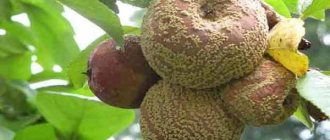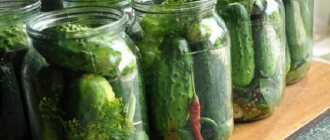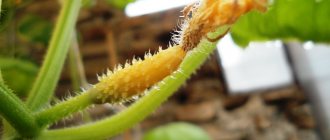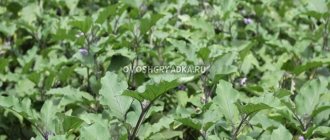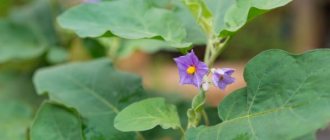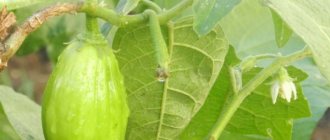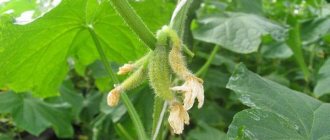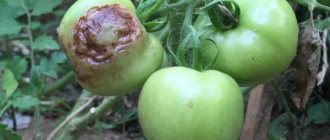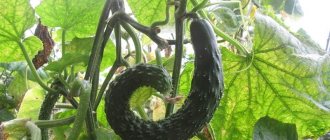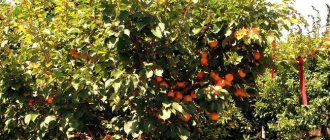Svetlana Leonova
| 20513 | 2 | Print Click Print or CTRL+P to print the page |
There may be several reasons for the yellowing of eggplants. Eggplants are quite popular among gardeners in our country, and if in the south of Russia it is allowed to grow this vegetable crop on ridges in open ground, then for the middle zone and northern regions it is necessary to use greenhouses and hotbeds. To grow a good harvest of eggplants, it is enough to comply with all the requirements imposed by the technology of growing vegetable crops in a greenhouse. However, many gardeners often face the problem of yellowing leaves or fruits and wonder why this phenomenon occurs and what to do in such a situation.
Eggplant Tomato Cannibal
Early variety. The fruits are very small, round, flattened, strongly reminiscent of tomatoes. The color of the fruit during ripening changes from dark green to yellow and orange-red.
As you can see, beds with eggplants can become not only a source of vitamins, but also a real decoration for the site.
Do you grow any exotic varieties and hybrids of eggplant? If yes, share your comments and photos of your “favorites.”
You may also be interested in material about Bicolor Vegetables.
The fruits are turning yellow
Eggplant fruits turn yellow due to:
- lack of nitrogen in the soil,
- lack of moisture,
- presence of diseases.
Photo: fungal disease Phomopsis (dry rot) of eggplant
The yellowness of the fruits of purple varieties is the beginning of seed ripening, the fruits have been overexposed, the phase of technical ripeness has passed.
But if the plant looks strong and healthy, there are no spots on the leaves, all preventive measures and fertilizing have been carried out, there is enough water in the soil and the weather is favorable for the growth and development of plants - it is probably some kind of yellow-fruited Asian variety.
To get fruits of the desired color and weight, you should buy seeds from a trusted seller or manufacturer.
Use in cooking
In order for eggplants to become your loved ones’ favorite dish, it is better not to forget about some features of their preparation.
- This fruit goes well with classic vegetable stew ingredients such as zucchini, peppers or potatoes.
- They can be stuffed, for example, with a mixture of cheese, crushed bread, eggs and tomatoes.
- These fruits make excellent sauces, as well as eggplant caviar.
Eggplant is a godsend for those who want to try vegetarian dishes, because you can use it to prepare a lot of interesting dishes, for example, casseroles, cutlets, to diversify your diet without meat.
Note to the housewife: these fruits usually quickly absorb the oil in which they are cooked. To prevent this from happening and for the berry to remain beneficial for the human body, just cut it into pieces and soak for 15 minutes before cooking.
Whether to peel off the purple peel is a matter of taste and each particular dish. For example, when baking in the oven or stuffing, the crust will help maintain its shape, but in a stew you can do without it.
If desired, eggplants can even be eaten raw. However, their taste is quite peculiar, with a bitterness. In addition, you should be absolutely sure of their freshness: if the fruit, for example, has darkened inside, it is better not to eat it. It is believed that the benefits of raw fruits are no less than those of steamed ones, so I personally prefer to heat them before serving.
How to get rid of bitterness
Some housewives do not like to cook eggplants because of the bitter taste that they sometimes develop. In fact, this can be easily avoided by soaking the fruits in salted water. After just half an hour, you can wash the slices and start cooking them - the bitterness will no longer bother you.
What to do with yellowed leaves
It's no secret that any problem can be eliminated if you understand the reasons for its occurrence. First of all, the plant is inspected to identify the presence of white and dry spots on it. At such a moment, it is recommended to use a magnifying glass. If necessary, necessary measures can be taken to get rid of the problem.
Fertilizing the soil
- Be sure to feed the soil. Complex formulations are added that contain the necessary macroelements and minerals;
- fertilizers containing nitrogen are used;
- Many people use yeast or milk solutions as additional means;
Eliminating irrigation errors
- when watering, the required amount of moisture is supplied;
- sometimes you should not water for several days to allow the soil to dry out;
Pest treatment
- one of the preventive measures is treatment with fungicides;
- Spraying is carried out with whey, infusion of onion or garlic peels, and soapy water.
Solutions are applied to the surface of the affected leaves so that each area is treated. When the disease subsides, the eggplant gains strength again and continues its development.
If it is not possible to carry out timely processing, protect healthy bushes from such an undesirable neighborhood. For this purpose, the affected plants are simply removed.
Eggplant seedlings with yellowed and dry leaves
Preventive measures
To prevent eggplants from overgrowing, they must be collected on time. It is better to pick slightly unripe fruits with thin skin and unformed seeds than to be late and get a harvest that is unsuitable for food.
Important! To understand whether the fruit has reached technical ripeness, you need to lightly press it without tearing it from the bush. A small dent should appear and disappear after a few seconds. If the touch mark does not disappear, the eggplant is overripe and should be left for seed.
Fruits can also turn green due to improper care. Experts recommend following the following rules for growing eggplants :
- For planting, you should choose a well-lit place protected from the wind.
- The thickening of the bushes should not be allowed. If necessary, the leaves covering the flowers and fruits must be removed (is it necessary to pinch and pinch eggplants?).
- It is important to observe crop rotation. It is not recommended to plant the crop in beds where tomatoes, potatoes, tobacco or eggplants themselves grew last year.
- Before planting, the soil should be fertilized. Humus, bird droppings, and mullein are suitable for this. Dolomite flour is used to normalize acidity.
- To prevent the occurrence of various diseases and attacks by pests that slow down the growth of fruits and cause them to spoil, before planting it is necessary to put a handful of ash in each hole or pour out 1.5 liters of a weak solution of manganese.
- You can start planting seedlings when the air temperature reaches about +18 0C and the soil warms up to +150C.
- Plants need to be watered once a week with warm water. In this case, moisture should not get on the leaves. After watering, it is useful to loosen the soil in the root area and remove weeds.
Pay attention to other materials from our experts. From them you will learn about the intricacies of growing eggplants in open and protected ground, including in Siberia and the Moscow region, as well as why eggplant seeds do not germinate and fruits do not set.
The greening of eggplants, which is unusual for the variety, indicates the accumulation of the dangerous substance solanine in the fruits. It is important to properly care for the crop and harvest it in a timely manner, otherwise the fruits will become harmful to health.
Green varieties
There aren't that many green eggplants. They differ in appearance and taste. In our latitudes, the following green varieties are mainly grown:
Alenka
This variety is one of the most popular among green eggplants. It is distinguished by an early period of fruit ripening - 108 days from the day of sowing the seed. It is recommended to grow the crop in a greenhouse. The best time to sow seeds for seedlings is February and March. In this case, the peak of fruiting will be in August and September.
The plant of this green variety is small, up to 70 cm high. This compactness allows you to plant bushes with a frequency of 4-6 pieces per 1 m2 of soil. At the same time, the fertility of the crop is quite high, reaching 8 kg/m2.
The shape of the fruit is familiar to such a crop as eggplant - teardrop-shaped. The average length of the vegetable is 15 cm, weight 320-350 g. It is worth noting that the eggplant is green not only on the outside, but also on the inside. Its flesh is greenish in color. The juiciness and pleasant taste of the pulp allows you to consume the fruit raw. As a rule, this is indicated by a characteristic inscription on the package of seeds. The fruits of this variety can be seen in the photo below.
Green
The fruits of this variety are spherical in shape. They are quite large, weighing up to 300 g. The pulp of eggplants is light green, sweetish with a distinct mushroom flavor. The variety is distinguished by its early ripening period: just over 105 days pass from the day of sowing the seed to fruiting.
It is recommended to grow the variety in open areas. To get an early harvest, seeds should be sown for seedlings in mid-March. It is necessary to dive it into the ground no earlier than the end of May and no later than mid-June. An adult plant is quite small in size, so it can be planted 5 pieces per 1 m2 of soil. The yield of the variety reaches 7 kg/m2. You can see the Green Eggplant in the photo below.
Green F1
Despite the similar name of this hybrid with the variety described above, their fruits are radically different in shape and taste. You can see the external difference by comparing the photos.
The fruits of the hybrid are light green, salad color. They have an elongated cylindrical, slightly flattened shape. Their length reaches 20-25 cm, weight no more than 300 g. The flesh of the fruit is light, dense, and contains absolutely no bitterness.
The height of the bush does not exceed 70 cm, which makes caring for the plant easier and allows you to plant 4-5 bushes per 1 m2 of soil. The plant is adapted to open and protected soil. The variety is characterized by an average ripening period of up to 115 days after sowing the seeds. The yield of the hybrid is excellent - up to 8 kg/m2.
Yoga
These eggplants are as unusual as their name. They have a curved cylindrical shape and are painted in a light green, light green color. At the same time, the flesh of the fruit is white, dense and quite tasty. This vegetable weighs 220-250 g.
The bushes of the plant are semi-spreading, low - up to 70 cm. They are grown in open ground, by seedlings. Grown seedlings are planted in the ground no earlier than mid-May. The fruit ripening period is 115 days after sowing the seed. The yield of the variety is high - up to 8 kg/m2.
Emerald F1
This green hybrid is characterized by increased resistance to low temperatures, stress, and disease. That is why seeds of this variety are preferred to be grown in mid-climatic latitudes. Plants are suitable for growing in open areas, as well as in greenhouses. The modest height of the bush (up to 70 cm) allows you to plant up to 6 of them per 1 m2 of soil.
The fruits are classically oval-shaped, green, weigh about 300 g. Their flesh is white, juicy, without bitterness. The fruit is suitable for consumption raw. For its ripening it takes from 105 to 110 days from the date of sowing the seed. A distinctive feature of the variety is the significant duration of the fruiting period, which provides yields of up to 8 kg/m2. Eggplants of this variety are shown in the photo.
Louisiana
Eggplants of this variety are representatives of American selection, which are successfully grown in domestic latitudes. Their main advantage is excellent yield up to 3 kg per bush. The plant bears fruit together, the fruits are cylindrical in shape, relatively even and approximately equal in length (15-20 cm). The average weight of one eggplant is 200 g.
The plant is medium-sized, not too spreading, so the planting frequency is 4-5 pcs/m2 of soil. The best growing conditions for the variety are greenhouses. The fruit ripening period is 110-115 days. You can see green vegetables of the Louisiana variety not only in the photo below, but also in the video, which describes the conditions for growing the crop in domestic latitudes and gives an objective assessment of the resulting harvest:
Thai green
Gardeners who have tried the seeds of this variety are confident that all the hassle of growing these fruits is worth it: eggplants have excellent taste, with tender, sweet, aromatic flesh. The chefs of the world's largest restaurants, where this variety is widely used, agree with them.
This variety is perfect for those who like to experiment on their plot of land. Already from the name it is clear that the homeland of the vegetable is the warm country of Thailand, but despite this, the crop can be grown in our latitudes. True, for this you will have to create ideal greenhouse conditions.
The fruits of this variety are long - up to 25 cm, bright green (example in the photo). They ripen 85 days after planting seedlings in the ground.
It is worth noting that the cost of Thai eggplant seeds is quite high.
Green Galaxy F1
This hybrid has spherical green fruits. There are characteristic white stripes on the surface of the eggplant. A distinctive feature of this variety is its excellent taste without bitterness and the thinnest peel of the fruit. The average weight of eggplant does not exceed 110 g.
The eggplant bush is vigorous, characterized by increased resistance to diseases, and is unpretentious to weather conditions.
Symptoms of poisoning and first aid
While eggplants are ripe, they are safe to eat. However, overripe fruits contain enough solanine to cause toxicity. In addition, the concentration of this toxin is high in those fruits that have been exposed to the sun for a long time. Fortunately, this can be easily avoided by first soaking the ripe vegetable in plain water.
Symptoms of solanine poisoning include the following:
- nausea, vomiting and diarrhea;
- abdominal pain and acute headaches;
- dilation of the pupils, their uneven reaction to light;
- loss of orientation in space;
- convulsive muscle contractions of the limbs;
- elevated body temperature.
In particularly severe cases, seizures, loss of consciousness and, ultimately, coma have occurred.
With regular and long-term intake of small doses of solanine into the body, the following is observed:
- sleep disturbance;
- increased drowsiness;
- skin rash, itching;
- mouth ulcers.
If after eating eggplant there are signs of poisoning:
- The first thing to do is to write down the medical history, first of all this concerns all the foods that the patient has eaten in the last twenty-four hours.
- After this, the general condition should be assessed. Most often, hospitalization is not required, but if there are neurological symptoms, impaired consciousness, heartbeat or breathing are impaired, an ambulance is needed.
- The next step is to rinse the stomach. This is a very important point, since it is necessary to help the body get rid of toxins that have entered it as soon as possible. This requires a large amount of plain boiled water to be drunk and then induced to vomit by pressing on the root of the tongue. This procedure should be repeated several times until the stomach is completely cleansed and the water coming out is almost clear.
- Then it is necessary to give the patient any sorbent drug that binds toxins and removes them from the body. The most famous and familiar is activated carbon, but recently a large number of more convenient and effective analogues have appeared (white carbon, Enterosgel, Polysorb, etc.).
If the patient requires hospitalization, intravenous infusions are used to stabilize the patient's condition, the purpose of which is to replenish the circulating blood volume and eliminate the symptoms of poisoning. Typically, glucose, sodium chloride solution and Hartmann's solution are used.
Why white dry spots may appear on leaves
The causative agent of white spotting is considered to be a fungus.
The root part of the crop is affected. On the affected areas of the stem, the disease manifests itself as a whitish coating, and sclerotia (solid inclusions) accumulate inside. After some time, they soften, which disrupts nutrition from the root system, and the bush dries and withers.
As a rule, this is a character problem for seedlings that have just been transplanted to a permanent place, and the air is still quite cool. Seedlings may even shed yellowed leaves.
The affected fruit becomes soft and watery, with areas of white coating. The disease is focal in nature, its pathogens can accumulate in the soil.
